Copyright
©The Author(s) 2022.
World J Gastroenterol. Mar 14, 2022; 28(10): 1024-1054
Published online Mar 14, 2022. doi: 10.3748/wjg.v28.i10.1024
Published online Mar 14, 2022. doi: 10.3748/wjg.v28.i10.1024
Figure 9 LAT1 ablation affects the initial metabolic adaptation that is necessary for the efficient repair after acute pancreatitis.
Acinar cells have a pyramidal shape and display a typical secretory machinery with a well-developed rough endoplasmic reticulum (RER) and Golgi apparatus (Golgi), which are localized to the perinuclear region, as well as lysosomes (Lys). In the apical region, digestive enzymes are stored in zymogen granules (ZG). A: Amino acid transporters (AAT) are expressed on the basolateral membrane of acinar cells and are responsible for the transportation of amino acids into the cells to maintain the synthesis of secreted enzymes; this is so they can be used as an energy source and to guarantee cell growth and regeneration after injury. LAT1 exchanges leucine (Leu) with other neutral amino acids (nAA), and the amino acid flow acts as an upstream regulator of the mammalian target of rapamycin (mTOR) pathway, which regulates protein synthesis and enables cell differentiation/survival. Morphology, enzyme expression, and other AAT expressions did not differ between healthy LAT1 wild-type (LAT1-wt, white, left-hand panel) and healthy LAT1 knockout (LAT1-ko, gray, right-hand panel) mice over the period observed in this study; B: During the early phase of AP, the remaining acinar cells entered a metabolic arrest, dedifferentiated, and temporarily reduced their secretory phenotype. An increase in autophagy (AL, autolysosome), followed by the re-activation of the mTOR pathway is decisive for the later steps of regeneration. LAT1 expression is maintained on acinar cells of LAT1-wt mice in this early phase, and it plays a role in the reactivation of mTOR. In LAT1-ko mice, the massive reduction of secretory enzyme expression was accompanied by markers of defective autophagy and a less-efficient activation of mTOR; C: Three days after the initial injury, LAT1-ko acinar cells were less differentiated and presented more areas of acinar-to-ductal metaplasia (ADM), expressed less secretory enzymes, and showed increased fibrosis. The delayed regeneration observed in acinar cells lacking LAT1 suggests that this occurred as a result of the improperly activated early metabolic response after injury.
- Citation: Hagen CM, Roth E, Graf TR, Verrey F, Graf R, Gupta A, Pellegrini G, Poncet N, Camargo SMR. Loss of LAT1 sex-dependently delays recovery after caerulein-induced acute pancreatitis. World J Gastroenterol 2022; 28(10): 1024-1054
- URL: https://www.wjgnet.com/1007-9327/full/v28/i10/1024.htm
- DOI: https://dx.doi.org/10.3748/wjg.v28.i10.1024









